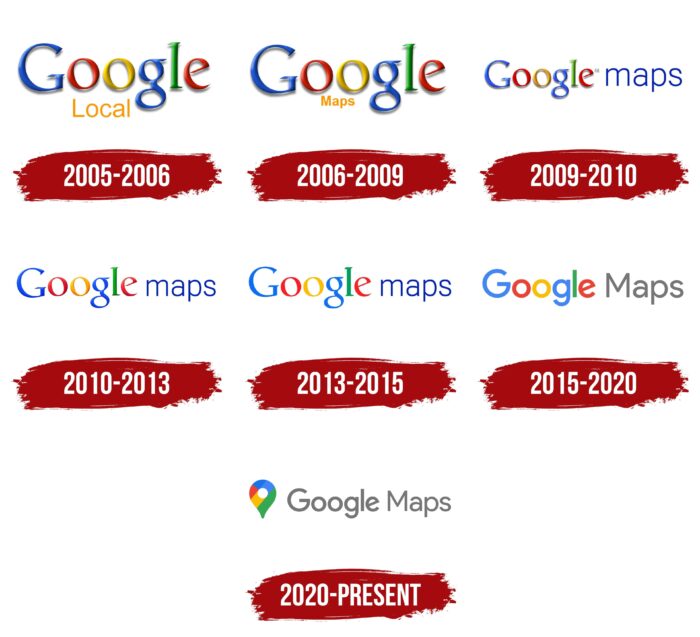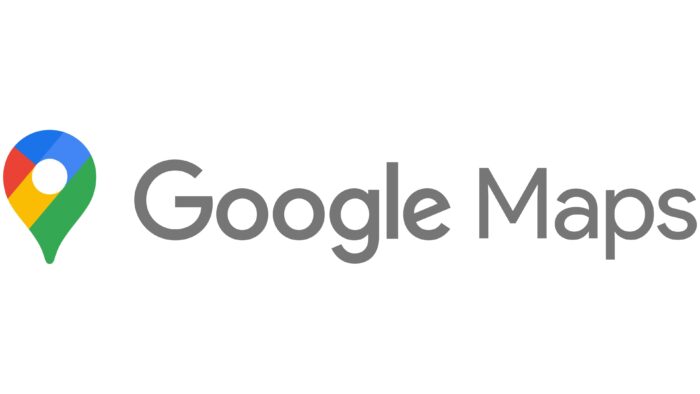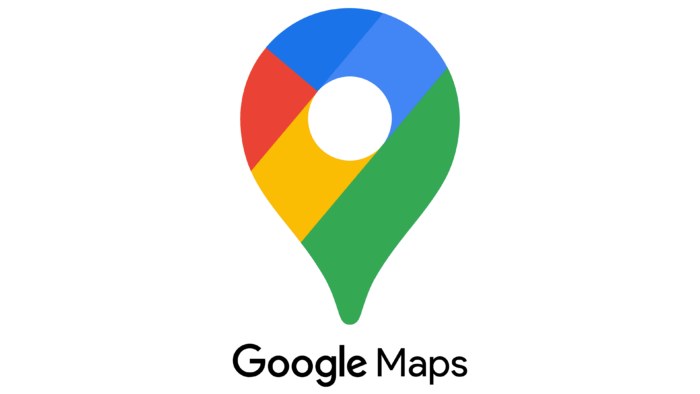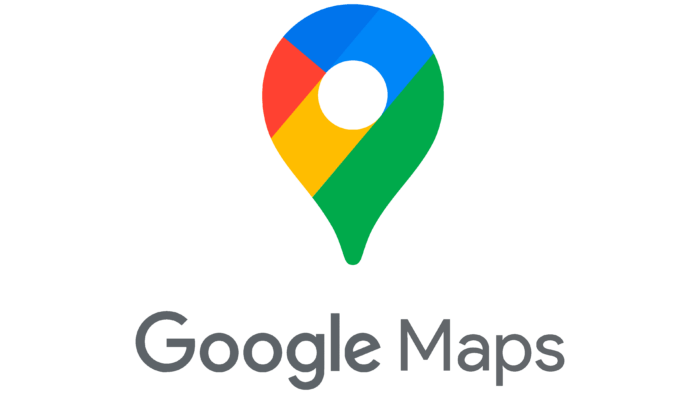The Google Maps logo is a symbol of location orientation. Maps will always show in which direction to move and what is nearby. The bright shades of the emblem are the personification of diversity and system settings for various types of landmarks.
Google Maps: Brand overview
| Founded: | February 8, 2005 |
| Founder: | |
| Headquarters: | United States |
| Website: | google.com |
The main task of Google Maps is to map the Earth, which helps to navigate the terrain. Previously, this service was only used as a tool to get from point “A” to point “B.” Over time, it has become a gateway to exploring the world because it has unique features in addition to step-by-step instructions. For example, in the app, you can explore panoramic views of the streets, find out the occupancy of public transport, see the interiors of public establishments, read reviews of companies, and find the right hotel or restaurant. The web platform provides detailed information about different regions, useful for both travelers and those who just went shopping.
Google Corporation got its mapping service in early 2005. It bought the project from the Rasmussen brothers, who in 2003 created the Tile-server with Where 2 Technologies. They were invited to join the development team of Google Maps so that the famous brothers could improve their idea and surpass all competitors in the field of cartography. The first achievement of the app was the “drag and drop” map, which no one else had before.
The features were continuously improved and supplemented. Satellite images, panoramic images, and data from aerial surveys are now available to users. It is possible to plan routes by any transport.
Meaning and History
The web service is compatible with iOS and Android systems, so almost all owners know its logo on mobile devices. Google Maps symbol has constantly evolved. It has evolved from a multicolored verbal sign into a combined logo containing a gray inscription and a colorful drop-shaped pin – the so-called marker. This pin is patent-protected and copyrighted by Google Corporation.
2005 – 2006
In 2005, the first version of the program was launched. It was briefly renamed Google Local, which was reflected in the logo. The first word was written in the style of the Google corporate symbol. The designers used the corporate serif font and kept the iconic color scheme, which included blue (both “g”), red (“e” and “o”), yellow (another “o”), and green (“l”). All of the letters had blurred gray shadows and a gradient.
The second part of the name was below the double “oo.” A bold sans serif font and a solid orange color were chosen.
2006 – 2009
In 2006, the service was finally renamed Google Maps. As a result, the word “Local” was replaced by “Maps” on the logo, but the lettering style remained the same. One of the reasons for the rebranding was international expansion: the application expanded to dozens of countries, including Germany, Canada, and the UK.
2009 – 2010
In 2009, the designers placed the word “maps” on the right side. In doing so, they repainted it blue and lowered all the letters to make the style consistent.
2010 – 2013
After another program update, the “Google” inscription was removed from the glow and gray outline. The gradient remained but became less pronounced.
2013 – 2015
In 2013, the trend towards simplification intensified. Transitions of different shades disappeared, and colors were lightened. The emblem modification coincided with opening a new mapping site, where many personalized features were added and a view of the Earth from space was added.
2015 – 2020
In keeping with Google’s global rebranding, Google Maps began using an updated logo. A bold grotesque font has replaced the font in the first part of the name with the same thickness of lines. As for the second half of the lettering, the developers repainted it in gray and made the letter “M” capitalized.
2020 – today
The most famous transformation of the visual identity of Google Maps took place in 2020. This is how the web-based mapping service celebrated its 15th anniversary, accompanying it with another expansion of features in the mobile app. For the first time, a pin appeared on the brand logo, which used to be only on the icon. It is a stylized icon in the form of an inverted drop with a round hole inside. It symbolizes the starting and ending point of the journey. It reflects the years-long evolution of the online platform: the transition from a conventional navigation system to a full-fledged assistant and informer.
The drop-shaped symbol is painted in Google’s signature colors: red, blue, yellow, and green. They are presented as separate blocks, with the blue having two shades: one lighter and one darker. The designers made the lettering completely gray to keep the logo from being too mottled. The first word is bolder than the second, so they are visually distinguished.
Icon
The Google Maps app icon has evolved several times. The last update took place in 2020 when the developers improved the interface and added several useful features. Previously, the main symbol of the service was a stationery button with a map. This element looks simpler because the designers removed the hint of a map plan of the area and left only a drop pin. Overall, the icon is consistent with Google’s corporate branding in both colors and shapes.
2009 – 2012
The 2009 version contained a schematic map showing intersecting streets. The roads were yellow and light gray, and the spaces in between were brown and dark gray. Because of the division of the pattern into three blocks of color, it looked as if the map was bent in two places. This made the icon look three-dimensional, and the shadows at the bottom further enhanced the 3D effect. On one of the folds was a glowing blue circle, a conventional “marker” indicating the user’s location or route’s endpoint. The designers made the pin look three-dimensional by adding radial gradients, shadows, and glow.
2012 – 2014
In 2012, the Android app icon was updated. First, the fold lines and shape of the sheet were changed, resulting in flatter edges. Second, the scale of the map was increased so that it only fit one yellow intersection, which divided the space into three parts: blue, green, and light brown. Third, the designers made the pin red and moved it to the right side. And the left half was taken up by a big white letter “g” in lower case.
2014 – 2015
After a slight modification, the map lost its volume and became two-dimensional. The developers made it look like a square with rounded corners. The lowercase “g” was on the upper left on a green background. Then there was a diagonal dividing line of yellow and two triangles (blue and dark gray), with a light gray stripe in between. The red drop pin became large and took up space at the intersection of the two fragments.
2015 – 2020
The 2015 changes were not significant. The designers changed the lowercase “g” to a capital “g” using Google’s original font.
2020 – today
The Google Maps service brightly celebrated its 15th anniversary by updating the app’s icon. In the modern version, the pin symbol has its bottom edge cut off, and the circle in the middle is white. The background is also repainted white because the stylized map has been removed. The stationery button is no longer red, although that color has been retained. Along with it are used blue (two shades), yellow and green – the basis of the corporate palette of Google.
Google Maps: Interesting Facts
Google Maps launched in February 2005 and quickly became popular.
- First Appearance: Google Maps launched as a basic map service and has grown into a full-blown navigation tool.
- Street View: Since 2007, Street View has allowed us to explore 360-degree views of places worldwide, starting with a few U.S. cities.
- Under the Sea: Not stopping at land, Google Maps takes you underwater to check out coral reefs and other oceanic wonders, thanks to a partnership with The Ocean Agency.
- Outer Space: Google Maps lets us roam the Moon and Mars, showing places like the Apollo mission landing sites.
- The Trekker: Google created a camera-equipped backpack to map trails, remote areas, and inside famous landmarks, reaching places cars can’t go.
- Developer Tools: Since 2005, the Google Maps API has allowed website and app developers to use Google Maps in their projects.
- Live Traffic: Google Maps shows real-time traffic information using smartphone data, road sensors, and past traffic patterns.
- Inside Look: It also offers maps of indoor places like airports and malls in some countries, making it easier to navigate large buildings.
- Greener Routes: Google Maps can suggest less fuel routes, considering hills and traffic, to help you drive more eco-friendly.
- Solar Potential: Using its data, Google’s Project Sunroof estimates how much money you could save by putting solar panels on your roof.
Google Maps has evolved into a tool that helps us navigate and explore the world uniquely, from deep-sea dives to space exploration, and even helps us make eco-friendly choices.
Font and Colors
The absence of a map on the icon and logo of Google Maps can be interpreted as a hidden message. Initially, the app was an alternative to a paper plan of the area because it helped construct routes. But with the addition of new features, it turned into a global GPS system with the ability to analyze all the surrounding objects. The service has become a tool for exploring the world, so using a clerical button without a map tells you that location comes first. After all, almost any location on Google Maps can be explored by reading reviews about it and looking at photos.
The marker symbol in the form of an upside-down blob only became part of the official logo of the program in 2020. But it has existed before: it has been used in promotional materials and the app in the past. The pin icon was designed by Jens Eilstrup Rasmussen, who wanted to use a simple icon to indicate a location on a map. The drop-shaped shape was chosen specifically so that the graphic element would not cover the marked points.
The new Google Maps icon is similar to other symbols of the Google branding system – primarily because of its colors. It’s painted in red, yellow, blue and green, with blue being two shades. On the logo, a stylized pin is complemented by gray lettering. For the name of the web mapping service, the designers chose Product Sans font. All Google applications use this grotesque, geometric font with a beveled “e.”
Google Maps color codes
| Cinnabar | Hex color: | #ea4335 |
|---|---|---|
| RGB: | 234 67 53 | |
| CMYK: | 0 71 77 8 | |
| Pantone: | PMS Bright Red C |
| Blue | Hex color: | #1a73e8 |
|---|---|---|
| RGB: | 26 115 232 | |
| CMYK: | 89 50 0 9 | |
| Pantone: | PMS 2727 C |
| Black | Hex color: | #4285f4 |
|---|---|---|
| RGB: | 66 133 244 | |
| CMYK: | 73 45 0 4 | |
| Pantone: | PMS 2727 C |
| Pigment Green | Hex color: | #34a853 |
|---|---|---|
| RGB: | 52 168 83 | |
| CMYK: | 69 0 51 34 | |
| Pantone: | PMS 7481 C |
| Fluorescent Orange | Hex color: | #fbbc04 |
|---|---|---|
| RGB: | 251 188 4 | |
| CMYK: | 0 25 98 2 | |
| Pantone: | PMS 7549 C |
| Nickel | Hex color: | #767676 |
|---|---|---|
| RGB: | 118 118 118 | |
| CMYK: | 0 0 0 54 | |
| Pantone: | PMS Cool Gray 9 C |













